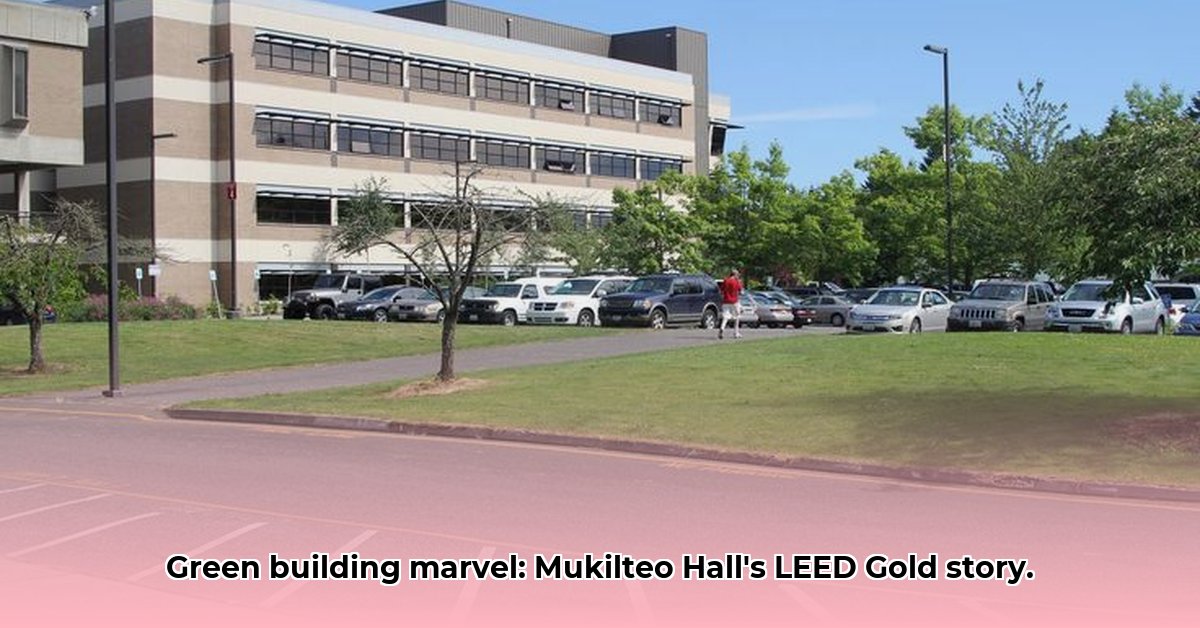
Mukilteo City Hall stands as a testament to the successful integration of sustainable design principles within a municipal building. Its achievement of LEED Gold certification highlights a commitment to environmental responsibility that extends beyond mere aesthetics, impacting both operational efficiency and long-term cost-effectiveness. This case study explores Mukilteo Hall's sustainable features, financial implications, challenges encountered, and offers a replicable framework for other municipalities aiming for similar achievements.
Innovative Sustainable Features: A Holistic Approach
Mukilteo Hall's LEED Gold certification is attributed to a comprehensive suite of sustainable design features. A key element is its hydronic geo-exchange system (a ground source heat pump system using the earth's stable temperature for heating and cooling), significantly reducing energy consumption and the building's carbon footprint. Complementing this is a green roof, which not only enhances aesthetics but also mitigates stormwater runoff, reducing strain on the city's drainage infrastructure. Furthermore, the incorporation of pervious concrete paving in parking areas allows rainwater infiltration, replenishing groundwater supplies and minimizing surface runoff. These integrated systems exemplify a holistic approach to sustainable design.
The Financial Picture: Balancing Upfront Costs with Long-Term Gains
While the initial construction costs of Mukilteo Hall were modestly higher (estimated 1-2%) than a conventional building, the long-term financial benefits are significant. Substantial reductions in energy and water consumption translate into lower operating costs, although a precise return on investment (ROI) for each individual sustainable feature requires detailed analysis. A comprehensive lifecycle cost analysis (LCA), encompassing maintenance, repairs, and energy consumption over the building’s lifespan (e.g., 50 years), is crucial for accurately assessing the project's economic viability. Such an analysis would include factors like equipment replacement schedules and potential maintenance cost escalation over time. How does this approach account for future energy price fluctuations and technological developments? These questions are critical for financial forecasting.
Challenges Faced: Adaptability and Data Limitations
The path to LEED Gold certification wasn't without challenges. One key obstacle was the scarcity of readily available, precise data on the ROI of individual sustainable features. This highlights the critical need for meticulous data collection and tracking from project inception. Furthermore, directly replicating the Mukilteo model in diverse geographical locations may prove challenging due to variations in climate, soil conditions, and local regulations. Adapting strategies to local contexts is pivotal for successful implementation.
A Blueprint for Success: Replicating Mukilteo Hall's Achievement
Other municipalities can learn from Mukilteo Hall's success by implementing the following steps:
Comprehensive Feasibility Studies: Conduct thorough studies to evaluate the feasibility and cost-effectiveness of various sustainable options within the specific local context, considering climate, regulations, and resource availability. A detailed energy audit is a necessary first step.
Detailed Cost-Benefit Analysis: Rigorously compare the costs and benefits of traditional and sustainable building methods, accounting for both initial investments and long-term operational savings. Utilize discounted cash flow analysis to properly value future savings.
Lifecycle Costing (LCC): Embrace a lifecycle costing approach, considering all costs (construction, maintenance, energy, etc.) across the entire building lifespan, for a comprehensive understanding of financial sustainability.
Stakeholder Engagement: Engage city officials, contractors, community members, and other stakeholders throughout the planning and implementation process, fostering broad support and successful execution.
Rigorous Data Collection and Monitoring: Monitor energy, water, and waste consumption meticulously to ascertain the effectiveness of sustainable measures. This data informs future projects and enhances continuous improvement.
Managing Potential Risks: Proactive Mitigation Strategies
Sustainable building systems inherently present certain risks, necessitating proactive mitigation. A structured risk assessment matrix, as illustrated below, is essential:
| Technology/System | Risk Level | Mitigation Strategies |
|---|---|---|
| Hydronic Geo-Exchange | Moderate | Regular maintenance, system inspections, redundant systems, contingency planning for power outages |
| Green Roof | Low | Careful species selection, drainage system maintenance, regular inspections, weed control |
| Pervious Concrete | Low | Regular cleaning, mitigation strategies for potential clogging, material selection appropriate for local conditions |
Conclusion: Building a Sustainable Future
Mukilteo City Hall showcases the feasibility of combining environmental responsibility with economic prudence in municipal construction. By learning from its experience, other municipalities can build sustainable and resilient infrastructure, contributing to healthier environments and more sustainable communities. The ongoing evolution of sustainable building practices continually unlocks more innovative and effective solutions. Adaptability and continuous learning are key to long-term success.